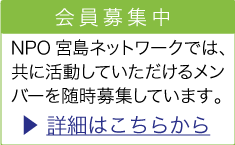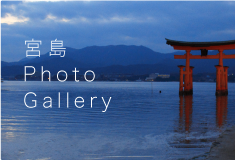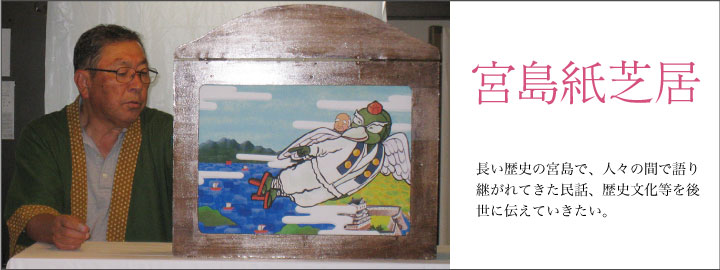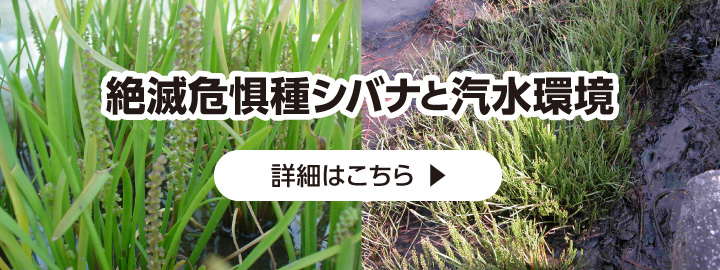Triglochin
Triglochin maritima L.
In the Tsutsumigaura Nature Park located on the northwest side ofMiyajima Island, there is a pond whose surrounding area is brackish marshes. Here, the endangered halophyte, seaside arrowgrass Triglochin maritima, L. (Japanese name: Shibana) is found. Volunteers from wildlife conservation groups are practicing to protect the plant and its habitat.
A signboard with the following explanation has been placed near the pond to introduce the plant Shibana to visitors and call for their attention.
An endangered species, Triglochin maritima, and brackish water environment
Seaside arrowgrass, Triglochin maritima, L. (Japanese name: Shibana), is a perennial halophytic (saltwater loving) herb growing in coastal salt marshes. The leaves are linear with rounded tips, have sheathing bases, and are bright green in color. The flowers are small, green and arranged in erect racemes; the flowering season is September.
The Japanese name Shibana is a derivation of “shioba-na”: “shioba” means ‘salt field’ like a salt evaporation pond, and “-na” meaning a herb or vegetable.
The habitat of Shibana is brackish water environments which result from seawater and freshwater mixing together, with salinity conditions changing constantly, depending on tidal levels. The pond in the Tsutsumiga-ura Nature Park located on the northwest side of Miyajima Island is a brackish water habitat with surrounding brackish marshes where Shibana grows, along with Ruppia maritima L. (Ruppiaceae; Japanese name: Kawatsurumo) and Eleocharis parvula (Roem. & Schult.) Link ex Bluff, Nees & Schauer (Cyperaceae; Japanese name: Chaboi).

The plant Shibana is listed as an endangered species in the red list of Japan as well as the red list of Hiroshima Prefecture, although previously it was widely distributed from Hokkaido to Kyushu. This drastic decrease of Shibana has resulted from coastal development and reclamation, elimination of salt fields, and changes in nature. Currently, there are only a few places in Hiroshima Prefecture where the growth of Shibana is confirmed.
On Miyajima Island, sika deer have been observed feeding on Shibana. At this pond, the damage is controlled by protecting the plant with wire netting. Since 2002, local residents interested in the biological conservation of the island, volunteers of wildlife conservation groups, and students and researchers of Hiroshima University have been working to protect the plant and its habitat. A signboard has been placed near the pond to introduce the plant to visitors and call their attention to it and its significance.

November 2022 by Non-profit organization Miyajima Network
For more information on the plant Shibana, please visit the following page of the Miyajima Natural Botanical Garden of Hiroshima University.
URL: https://www.digital-museum.hiroshima-u.ac.jp/~main/index.php/Triglochin_maritima_in_Miyajima_Island
シバナ
宮島の包ヶ浦自然公園の中には、貴重な植物シバナが生育する湿地(池)があり、有志がその保護活動をしています。
池のそばには、下のような説明を書いた看板を設置して、訪れる人へシバナを紹介し注意を呼びかけています。
絶滅危惧種シバナと 汽水環境
シバナTriglochin maritima, L.はシバナ科の多年草で、汽水域の泥地に生え、小さな花が9月頃に咲きます。葉は肉厚で柔らかく、先が丸くて明るい緑色で、他の植物と容易に区別できます。
和名シバナは、塩場菜(しおばな)が転じたもので、塩場は塩田のことです。
シバナが生育するのは、汽水域とよばれる海水と淡水が混じる環境です。汽水域は潮位の変化によって塩分濃度が変わり、保全が難しい場所です。この池は汽水環境になっており、チャボイやカワツルモとともにシバナが生育しています。

現在、シバナは環境省および広島県の絶滅危惧種に指定されています。昔は北海道から鹿児島まで広く分布していて、瀬戸内海沿岸にも多くの生育地がありましたが、海岸開発や自然の変化などで育つ環境が減り、各地で激減しています。現在、広島県内で生育が確認できるのは数か所になっています。
宮島ではシカがシバナを好んで食べるため、この池では金網で保護しています。平成14(2002)年から、旧宮島町・広島大学宮島自然植物実験所・有志のみなさんが保全した結果、数株だったシバナは5年後には100株を超えるまでになりました。その後も保護活動を継続してシバナを守っています。

2022年11月 特定非営利活動法人 宮島ネットワーク
シバナについて詳しい説明は、広島大学・宮島自然植物実験所の該当ページへ
URL: https://www.digital-museum.hiroshima-u.ac.jp/~main/index.php/Triglochin_maritima_in_Miyajima_Island










